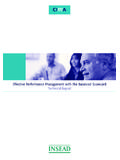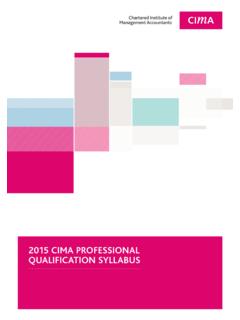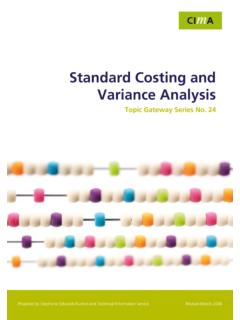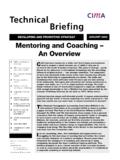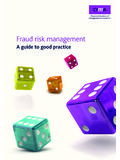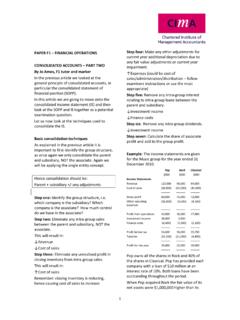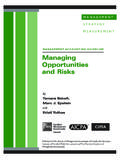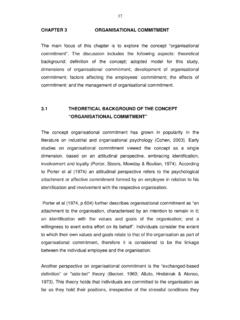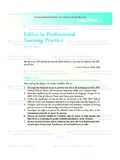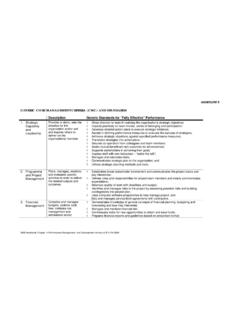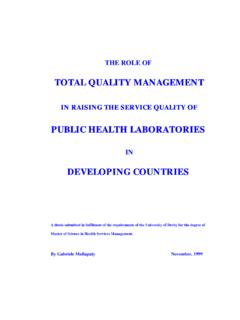Transcription of Sample Scheme of Work - CIMA
1 Sample Scheme of work Implementation guide 6. E2 Enterprise Management Learning outcomes Unit Topics Class Homework questions questions Discuss concepts in 1 Concept of strategy Q3 (Ch 1) Q2 (Ch 1). established and emergent Model of rational strategy thinking in strategic process management Stakeholders Criticisms of rational model Strategy and small business Alternative approaches to strategy formulation Explain the relationships 2 Levels of strategy Q4, Q5. between different levels of Formal top-down strategy (Ch 1). strategy in organisations process Complex organisational forms Network organisations Compare and contrast 3 Achieving competitive approaches to strategy advantage Q1, Q6. formulation objectives of (Ch 1). shareholders Discuss the nature of 4 Environmental Q3 (Ch 3) Q1, Q2 a competitive environments analysis (Ch 2).
2 Causes of environmental uncertainty Sources of information for environmental analysis Internationalisation and globalisation Chapter and questions references relate to CIMA's official learning systems, the only texts written and endorsed by the CIMA faculty. For more information on the use or adoption of CIMA's official learning systems, please contact Neil Boon: T. 01865 844758 E. Distinguish between 5 and Competitor Q3 (Ch 2). different types of analysis and accounting competitive environments Global economic Q6 (Ch 3). environment National competitive advantages Country analysis and political risk Identify a project, a 6 Project management Q1 (Ch 4). programme and their definitions attributes Project characteristics Project life cycle Examples of projects Apply suitable structures 7 Project as a conversion Q4 (Ch 4) Q5 (Ch 4).
3 And frameworks to projects process Q7 (Ch 5). to identify common project Strategy and scope of a management issues project Roles and responsibilities Produce a strategy for a of project manager project Skills of project manager Construct an outline of the process of project management Identify the characteristics 8 Project Q1 (Ch 5). of each phase in the project management process process Apply key tools and 9 Tools and techniques for Q4 (Ch 5) Q2, Q6, techniques, including the project planning Q8, Q10, evaluation of proposals Project management Q11, Q12. software (Ch 5). Produce a basic project plan incorporating strategies for dealing with uncertainty, in the context of a simple project Identify structural and 10 Project teams Q2 (Ch 4) Q3 (Ch 4). leadership issues that will Project organisation be faced in managing a structure project team Why some projects fail Chapter and questions references relate to CIMA's official learning systems, the only texts written and endorsed by the CIMA faculty.
4 For more information on the use or adoption of CIMA's official learning systems, please contact Neil Boon: T. 01865 844758 E. Compare and contrast 11 Monitoring and controlling Q3 (Ch 5) Q9, Q12. project control systems projects (Ch 5). Discuss the value of post- 12 Project completion and completion audit closure Post completion review Apply a process of and audit continuous improvement to projects Explain the roles of key 13 Stakeholders Q6 (Ch 4). players in a project Project stakeholders organisation Recommend strategies for the management of stakeholder perceptions and expectations Discuss the concepts of 14 Power, authority, power, bureaucracy, responsibility and delegation authority, responsibility, Management theories leadership and delegation Roles of managers Discuss the concepts of 15 different perspectives of Q2, Q3, Q4.
5 Power, bureaucracy, leadership , Q5 (Ch 6). authority, responsibility, Leadership theories leadership and delegation Transformational leaders Entrepreneurs Demonstrate the importance 16 Organisational culture Q1 (Ch 6) Q6 (Ch 6). of organisational culture Managing cultural diversity Identify the nature and 17 Nature of organisational Q2 b Q1, Q2, causes of conflict conflict (Ch 2) Q6, Q7. (Ch 9). Discuss alternative approaches to the management of conflict Chapter and questions references relate to CIMA's official learning systems, the only texts written and endorsed by the CIMA faculty. For more information on the use or adoption of CIMA's official learning systems, please contact Neil Boon: T. 01865 844758 E. Analyse the relationship 18 Handling grievances Q3 (Ch 8).
6 Between managers and Tribunal applications Q4 (Ch 9). their subordinates, including Termination of legal aspects affecting work employment and employment Fairness and commitment Health and safety Discuss the roles of 19 Communication and Q3, Q5. negotiation and negotiation (Ch 7). communication in the management process, both within an organisation and with external bodies Discuss the effectiveness of 20 Management of Q1 (Ch 8) Q 4, Q5. relationships between the finance function (Ch 8). finance function and other parts of the organisation Organisational and with external control system stakeholders Explain the process and importance of mentoring junior colleagues Identify tools for managing 21 Groups and teams Q1, Q2 Q4, Q6. and controlling individuals, (Ch 7) (Ch 7).
7 Teams and networks, and for managing group conflict Compare and contrast ways 22 Discipline Q3, Q5. to deal effectively with (Ch 9). discipline problems Analyse issues of business 23 Social responsibility Q1, Q2, ethics and corporate Business ethics Q4, Q5. governance Professional ethics (Ch 3). Corporate governance Q2 (Ch 8). Chapter and questions references relate to CIMA's official learning systems, the only texts written and endorsed by the CIMA faculty. For more information on the use or adoption of CIMA's official learning systems, please contact Neil Boon: T. 01865 844758 E.

